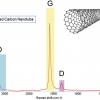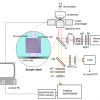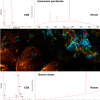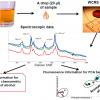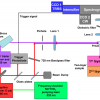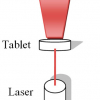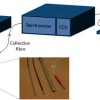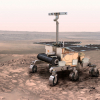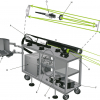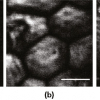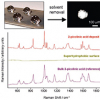Articles
Fuels and the taxes raised from their sale are a big business around the world. To control smuggling, counterfeiting, theft and product diversion, markers can be placed in the fuel. The use of a SERS active compounds as markers is described as well as the development of a portable instrument for detection of the markers in the field.
This article explains what is represented in a Raman spectrum of carbon nanotubes and how to optimise the measurement. There is actually significant diversity within samples of nanotubes which affects both the material properties and the Raman spectrum of the material.
Even though lead in fuel has been banned for a number of years, it is still present in by the roadside, as are many other pollutants from vehicles. The combination of Raman spectroscopy and µ-ED-XRF is of particular value. The advantage Raman has is in the possibility of focusing on individual grains, thereby obtaining the spectrum of each grain that comes from traffic-emitted particles.
Following lipids in the food chain: determination of the iodine value using Raman micro-spectroscopy
Raman spectroscopy is used to monitor the iodine value of algal-derived fish feed for its lipid content and to monitor algae samples for biofuel production.
Whilst fireworks are a great entertainment, they can also be used for illegal activities as well as potentially containing dangerous chemicals. The combination of Raman spectroscopy and SEM-EDS turns out to be a very efficient analytical method. In fact, these complementary techniques may also be used to analyse other kinds of pyrotechnic artefacts, low explosive formulations, high explosives, explosion residues etc.
Praveen Ashok and Kishan Dholakia of St Andrews University, UK, describe the scope of optofluidic devices that can be implemented using the waveguide confined Raman spectroscopy (WCRS) technique they have developed. I am particularly impressed by the sample size of whisky shown in Figure 2—true Scottish style!
Since attempts to blow up planes using liquid explosives, we have all been restricted in what we can take onboard when we fly. Raman spectroscopy is offering a solution. However, “Time-resolved Raman spectroscopy for non-invasive detection through non-transparent materials” by Ingeborg Iping Petterson and Freek Ariese argues that time-resolved Raman spectroscopy (TRRS) techniques provide better spatial selectivity than the major alternative, spatially offset Raman spectroscopy (SORS). Applications for through-skin measurements and depth analysis in catalytic extrudates are also described.
Counterfeiting is a major problem throughout the world and transmission Raman spectroscopy proves to be a very useful tool for fast and non-destructive detection of counterfeit pharmaceuticals.
This article surveys developments in the applications of Raman spectroscopy and the design of probes for use in endoscopes for the detection of early cancers in the throat and stomach.
Raman spectroscopy is to be used as one of the analytical techniques for the European Space Agency’s ExoMars mission to identify the geological and biogeological spectral signatures that could herald the presence of extinct or extant life on Mars. The article looks at the benefits of Raman spectroscopy for this and the research on Earth to build knowledge of the spectra of organisms living in extreme conditions here.
The problem of detecting, recognising and identifying explosives at significant standoff distances has proved one of the most difficult—and most important—challenges during recent years, being today, one of the most demanding applications of spectroscopic techniques. The limited number of sophisticated available techniques potentially capable of standoff detection of minimal amounts of explosives is based on laser spectroscopy. Of the recently developed techniques, Raman spectroscopy and laser-induced breakdown spectroscopy (LIBS) are considered significant for their potential for homeland defence applications.
Here, we focus on new trends in Raman spectroscopy to improve in vivo diagnosis. The use of Raman spectroscopy for real-time diagnosis of medical disease without the need for biopsy is among the most exciting and clinically relevant applications; four recent reports are presented. First, an approach to reduce fluorescent background of lung tissue in combination with a biomedical filtered Raman fibre optic probe was introduced in 2009 by Magee et al. Second, a fibre optic probe was developed for the CARS variant of Raman spectroscopy. Third, functional metal nanoparticles and carbon nanotubes were applied to a small animal model to collect Raman spectra non-invasively utilising the surface enhanced Raman scattering (SERS) effect. Finally, spatially offset Raman spectroscopy (SORS) has been presented as another non-invasive Raman-based method to probe deep bone subcutaneously in an animal model.
Jean-Philippe Echarda and Loïc Bertrandb
aLaboratoire de recherche et de restauration, Musée de la musique, Cité de la musique, 221 avenue Jean Jaurès, 75019 Paris, France. E-mail: [email protected]
bIPANEMA, synchrotron SOLEIL, Saint-Aubin, 91192 Gif-sur-Yvette cedex, France
Iain A. Larmour, Jennifer P.E.D. Gray and Steven E.J. Bell
Innovative Molecular Materials Group, School of Chemistry and Chemical Engineering, Queen’s University Belfast, Belfast, BT9 5AG, UK
During the last decade, the amount of counterfeit drugs on the worldwide market has rapidly increased. It is difficult to determine the exact scale of this problem, since not all counterfeit drugs are reported or even detected. The drugs that are often counterfeited can be divided into two groups, depending on the region where they are brought onto the market. The use of Raman spectroscopy in the pharmaceutical field has been increasing over the last few years. Raman spectroscopy has some specific benefits, which can be very useful for the detection of counterfeit drugs: a Raman spectrum can be recorded rapidly without any sample preparation. Moreover, not only does a Raman spectrum provide information about the active ingredient present in the drug, but also a Raman spectrum contains information on its concentration and allows identification of excipients present in the drug. So far, this technique has been used for the detection of different kinds of illicit drugs, such as cocaine, heroin and ecstasy, and also for the detection of counterfeit antimalarial and Viagra® tablets. This article will demonstrate the use of Raman spectroscopy as a fast and easy detection system for different counterfeit erectile dysfunction drugs. Three different genuine erectile dysfunction drugs are available on the market: Viagra®, Cialis® and Levitra®. Viagra® is the most commonly counterfeited drug, but the amount of counterfeit Cialis® has rapidly increased over the last few years. The possible counterfeits analysed consisted of two Viagra® tablets, SEYAGRA-GEL containing the same active ingredient as Viagra® and two tablets claiming to contain the same active ingredient as Cialis®.
A number of analytical applications in the area of security screening, medical diagnosis, drug authentication and quality control often require non-invasive probing of diffusely scattering (turbid) media in order to obtain chemical characterisation of deep-lying sample regions. Examples include non-invasive disease diagnosis, the detection of concealed explosives and illicit materials, the identification of counterfeit drugs and quality control applications in the pharmaceutical industry. Raman spectroscopy holds particular promise in this area due to its inherently high chemical specificity [exceeding that of near infrared (NIR) absorption spectroscopy and comparable with mid-infrared and THz methods], the ability to probe samples in the presence of water (the Raman scattering cross-section of water is very low) and its high penetration depth into turbid non-absorbing or weakly absorbing samples. On the downside, the technique is restricted to samples that do not exhibit strong fluorescence emission although this problem can, in the majority of cases, be avoided by using NIR excitation. Until recently, Raman techniques have generally been confined to applications involving surface layers of turbid media due to limitations imposed by the backscattering collection geometry common to the majority of commercial Raman probes. In principle, confocal Raman microscopy can potentially resolve objects to depths of up to several hundred micrometres. Deeper layers cannot be readily resolved and, typically, are overwhelmed by Raman and fluorescence signals emanating from the surface layer.
Raman spectroscopy was used to study the condition of the Victory sail. Molecular spectroscopic analysis of the sail fibres was needed to simulate the aged, degraded material, thereby effecting a better compatibility between the old and replacement materials which would assist in the preservation of this ancient, historic marine textile.
Fernando Rull Pérez and Jesus Martinez-Frias
Centro de Astrobiología, Unidad Asociada CSIC-Universidad de Valladolid, Facultad de Ciencias, 47006 Valladolid, Spain
Raman spectroscopy: a simple, non-destructive way to characterise diamond and diamond-like materials
Jacob Filik
School of Chemistry, University of Bristol, Bristol, BS8 1TS, UK
Simon FitzGerald
Horiba Jobin Yvon Ltd, 2 Dalston Gardens, Stanmore, Middlesex HA7 1BQ, UK. E-mail: [email protected]

